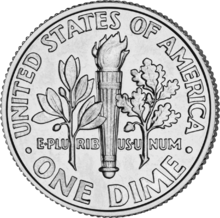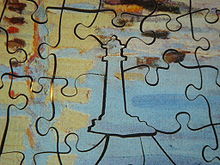|
Can it be that life on Earth is an accident...
 
In order for us to think logically about life originating simply by chance we need to digress into the nature of probability. Consider a coin. It has two sides, heads and tails, and a slightly crowned edge so that it has no chance of standing on edge on a hard, flat surface. Now let's toss the coin a few feet onto a marble floor. The coin will bounce a few times and perhaps spin around a bit before settling down on one side or the other. Under these conditions the probability of the coin winding up head side up are exactly 1 out of 2.
What is the probability of tossing two heads in a row? Since it is 1/2 for a single toss it must be 1/4 = (1/2) multiplied by (1/2) for two tosses. And for three tosses to all come up heads the probability is (1/2)x(1/2)x(1/2) = 1/8. In general the probability of a number n of tosses in a row coming all up the same is (1/2) raised to the nth power. for 10 tosses to all come up heads (or tails), the probability of success is (1/2)10 = 1/1024. Of course the same probability applies to simply tossing ten coins at once into the air and having the all land heads is exactly the same. The time separation between tosses does not come into consideration.

Now consider an interlocking jigsaw puzzle as see above. Let's look at a ten piece puzzle. What might be a reasonable estimate of the probability of taking the cover from the box of unassembled pieces, tossing all the pieces into the air from the box and having them land properly assembled. We are going to need to make some reasonable estimates to approximate the probability of assembling such a puzzle by this procedure in a single toss.
Let's assume that the puzzle was cut in such a way that there is a bit of clearance between the properly assembled pieces - enough that the pieces fit easily together and when assembled there is a quarter of a degree of angular play for each piece. Next let the average area of each opening in the puzzle with one piece missing be 1/100 of the total area in which a piece might land (constraining the falling pieces to land reasonably close together). As was the case in tossing coins, the time between pieces settling on the floor does not enter into the calculations so we can look at this event one piece at a time.
The first piece to hit the floor has, like the coin, a probability of 1/2 of landing picture side up. If that fails, the fate of no other piece matters. Once the first piece is in place, the proper location and angular orientation required of the other nine pieces is fixed. The probability of any of the other nine pieces matching the orientation required for it to fall into its assigned area in the puzzle is 0.25/360 = 1/1440 = 1/(1.44x103), the quarter degree slop allowed, divided by the total number of degrees in all orientations. Once properly aligned, each piece must land in an area that is 1/100 of the total possible. So the probability for a single piece after the first to land right side up in its proper place is (1/2)x(1/1440)x(1/100). The probability for all ten pieces to be successfully assembled in one toss then would be (1/2)(for the first piece) x (1/288000)9 = (approximately)3.668x10-50, very long odds against, even for such a sloppily cut puzzle of so few pieces.
So how many tosses would I have to make to have a 50/50 chance of success. Let's first work with the ten coins. Since probabilities must lie in the range from zero (for impossible events) and 1 (for inevitable events) it is sometimes convenient to work with the probability of failure rather than probability of success. The probability of failure is 1 minus the probability of success. So for the coins, the probability of failure for each toss is 1-1/1024 = (1024/1024)-(1/1024) = 1023/1024. For us to have a 50% chance of success, there must also be a 50% chance of failure. But remember the combined probability is the product of the individual probabilities so (1023/1024)n = 0.5 gives us a formula for n, the number of tosses needed to yield a 50% chance of success. Solving for n involves some mathematical sleight of hand dealing with logarithms and the answer is about 710 throws.
Let's apply this to the jigsaw puzzle. The probability of failure for a single toss is 1-3.668x10-50. This is a problem because the chance of failure for a single toss is so close to 1 that my computer cannot tell the difference. Let's solve that problem by using the number closest to, but less than, 1 that my computer can recognize. That is 0.9 followed by 29 more 9s. This assigns much too small a probability of failure to each toss but will give us a conservative estimate of the number of tosses. When I use that number in our formula for n I find n to be 6.93x1029 tosses to reach a 50% probability that one of them would be successful. In fact the actual number of tosses would be many times this number because I used too small a number (not close enough to 1) for the probability of failure of a single toss. Let's suppose that it takes a minute to toss the pieces, gather them up and toss them again. Then 1.3x1024 is a lower bound on the number of years of constant tossing to reach a 50% chance of that one of them was successful.
Just for comparison there have been about 1.37x1010 years since the big bang. That means if I somehow contrived to start tossing puzzle pieces at the time of the big bang, at the rate of one boxful per minute, my chances up till today of a successful throw would be so close
to zero as to be judged impossible.
Sharon is pretty good at assembling jigsaw puzzles. In three or four hours of actual working time she can assemble a 1000 piece puzzle. To people who failed to read the instructions and are trying to assemble the puzzle by repeatedly dumping the pieces out of the box, this would seem miraculous. I am not as good at jigsaw puzzles as Sharon is. Even I, though could assemble a 10 piece puzzle in... oh I don't know... maybe an hour. Whatever the time was it would be spectacularly less than 1.3x1024 years. It seems to me that a human being has an amazing capacity for producing unlikely results, achieving a gain over random chance of some 25 to 30 orders of magnitude.
I wonder which event is less likely, left to chance, the spontaneous assembly of a jigsaw puzzle or the construction of a living organism from nothing but the dust of dead stars and the radiation of a live one. It would seem, just from the fact that living organisms do exist on Earth, that creating life should be a great deal easier than assembling a ten-piece jigsaw puzzle. Life popped up in about 109 years on this planet, a factor of about 1.3x1015 before the jigsaw puzzle would have had a 50/50 chance of making it. It makes one wonder, doesn't it?
The size of the prokaryote is about 3X10-18 cubic meters, which equates to roughly 1012 atoms per cell. Let's assume that 60% of these atoms are hydrogen and oxygen, bound together to form H2O (water) molecules. There is not a lot of rigidity to water. It can be stirred about gently in a container without seriously affecting the structure immersed in it. The other 40% of the atoms have to be in specific locations relative to one another to make the whole thing work. That amounts to a 4X1011 piece three-dimensional puzzle. If the first prokaryote were to have sprung fully formed from random encouters among atoms, that would have to be considered truly miraculous. One of my correspondents has suggested that I was too hasty in dismissing life arising by accident. His objection and my response may be seen here.
Moving on to the next "perhaps" listed at the end of the "What is Life" page we will consider possibility of evolution bringing life out of inaminate matter.
|




